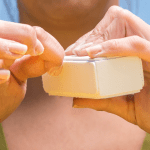Brittle Nails and Menopause
Brittle nails, medically known as onychorrhexis, are a common condition characterized by nails that break, crack, or chip easily. The term itself comes from the Greek words “onycho,” meaning nail, and “rhexis,” meaning bursting, which aptly describes the tendency of brittle nails to split and fracture. Healthy nails are typically strong and evenly formed, thanks to the production of keratin, a protein that forms the hard substance covering the tops of fingers and toes. When keratin production is disrupted, it can lead to an imbalance that manifests as brittle nails. Symptoms such as yellowing or curling at the tips can also indicate brittleness, signaling an underlying issue with nail health.
The Connection Between Menopause and Nail Health
Menopause, the natural decline in reproductive hormones when a woman reaches her 40s or 50s, can bring about a host of unexpected symptoms, including brittle nails. This may seem surprising, but the fluctuation and eventual decrease in estrogen levels during menopause can significantly impact the body’s hydration. Estrogen plays a crucial role in regulating water levels, and as these hormone levels drop, a woman’s ability to retain water diminishes. This dehydration affects not only the skin but also the nails, leading to dryness, brittleness, and an increased likelihood of breakage. Understanding this connection is vital for addressing nail health during menopause.
Overview of Natural Treatments for Brittle Nails
There are several natural treatments and lifestyle adjustments that can help improve the health of brittle nails during menopause. Protecting the nails from prolonged water exposure is essential; wearing gloves during activities like dishwashing can prevent water absorption and subsequent drying damage. A diet rich in essential fatty acids, such as those found in almonds and avocados, can strengthen nails from within. Hydration is equally important, and drinking plenty of water can counteract the effects of decreased estrogen levels.
Moisturizing the nails is another key strategy. Opt for hand moisturizers free from harsh chemicals that could exacerbate dryness, or consider natural alternatives like almond oil or Comfrey Cream to keep nails supple. Supplements containing nettle, silicon, and magnesium may also support nail health by enhancing keratin production and maintaining a healthy nervous system, which can be particularly beneficial during the stress of menopause. While these natural remedies can be effective, it’s important to consult with a healthcare provider to rule out other causes of nail brittleness and to discuss the best course of action for individual needs.
Identifying Brittle Nails
Characteristics of Brittle Nails
Brittle nails, medically known as onychorrhexis, are a common condition characterized by nails that are thin, dry, and prone to splitting or peeling. The nails may appear dull and lack the healthy shine typically associated with well-hydrated nails. In some cases, vertical ridges running from the cuticle to the tip of the nail can be observed. These ridges can lead to uneven nail surfaces and further contribute to the brittleness. Additionally, the cuticles may also be dry and prone to hangnails, exacerbating the overall fragile condition of the nails.
Common Causes and Contributing Factors
Several factors can contribute to the development of brittle nails during menopause. The primary culprit is the hormonal changes that occur during this period, particularly the decrease in estrogen levels. Estrogen plays a crucial role in regulating hydration and supporting keratin production, a protein that gives nails their strength. As estrogen levels drop, nails may become dehydrated, leading to reduced keratin and increased brittleness.
Other contributing factors include:
- Dehydration: Inadequate fluid intake can exacerbate nail dryness.
- Nutritional deficiencies: Lack of essential nutrients like biotin, collagen, zinc, and vitamins can affect nail health.
- Exposure to water and chemicals: Frequent hand washing or exposure to harsh chemicals can strip nails of their natural oils.
- Mechanical stress: Repeated minor traumas from daily activities can weaken nails over time.
- Use of nail products: Certain nail polishes and removers, especially those containing acetone, can contribute to nail dryness and fragility.
When to Be Concerned: Recognizing Abnormalities
While brittle nails can be a normal part of aging and menopause, certain signs may indicate a more serious underlying condition. It is important to be vigilant and seek medical advice if you notice:
- Changes in nail color, such as yellowing or dark streaks.
- Significant changes in nail shape or thickness.
- Persistent pain or swelling around the nails.
- Separation of the nail from the nail bed, known as onycholysis.
- Signs of infection, such as redness, warmth, or pus.
These symptoms could be indicative of fungal infections, nail psoriasis, or other dermatological conditions that require professional treatment. Additionally, if lifestyle changes and natural treatments do not improve the condition of your nails, or if you suspect that your brittle nails are not solely due to menopause, consulting with a healthcare provider is recommended. They may perform a physical examination, review your medical history, and possibly conduct tests to rule out other causes such as thyroid disorders or anemia.
The Role of Hormones in Nail Health
Estrogen’s Impact on Hydration and Nail Strength
Estrogen plays a pivotal role in maintaining the hydration and strength of nails. This hormone helps regulate the body’s ability to retain water, which is crucial for the health of keratinocytes, the cells that produce keratin. Keratin is the structural protein that makes up the nail. When estrogen levels drop during menopause, the body’s keratin production can decrease, leading to nails that are more susceptible to dryness, brittleness, and breakage. The hydration of the nail bed and cuticle is also compromised, further exacerbating the problem of brittle nails.
How Hormonal Changes During Menopause Affect Nails
As women enter menopause, the natural decline in estrogen levels has a direct impact on nail health. The reduction in estrogen can lead to a decrease in the number of epidermal keratinocytes, resulting in thinner, weaker nails. This hormonal change can also affect the skin’s ability to retain moisture, leading to dehydration. Consequently, nails may become more fragile, prone to splitting, and may exhibit a lackluster appearance. Additionally, the onset of menopause can bring about other symptoms such as hot flashes and night sweats, which can indirectly contribute to overall dehydration, further affecting nail strength and health.
Other Hormonal Factors Influencing Nail Condition
Beyond estrogen, other hormonal changes can influence nail health during menopause. For instance, thyroid hormones, which are often imbalanced during this time, play a role in the growth and repair of nail tissue. An underactive thyroid (hypothyroidism) can lead to brittle nails, as well as other symptoms that may affect nail appearance, such as hair loss and dry skin. Additionally, iron deficiency, which can be more common in menopausal women due to changes in menstruation patterns, can lead to spoon-shaped nails or vertical ridges on the nails. It is important for women to monitor their hormonal health and seek professional advice if they notice significant changes in their nail condition.
In summary, the hormonal fluctuations that occur during menopause have a significant impact on nail health. Estrogen’s role in hydration and keratin production is crucial for maintaining strong, resilient nails. The decline in estrogen during menopause can lead to dry, brittle nails, while other hormonal imbalances can further affect nail condition. Understanding these connections can help in developing strategies to manage and improve nail health during menopause.
Natural Strategies for Managing Brittle Nails
Importance of Hydration and Diet
Hydration plays a crucial role in maintaining nail health, especially during menopause. Adequate water intake helps to keep the nail bed and cuticles moisturized, preventing brittleness. It is recommended to drink at least 8 glasses of water daily, and to include hydrating foods such as cucumbers, melons, and leafy greens in your diet. A balanced diet rich in vitamins and minerals supports nail strength and growth. Foods high in protein, vitamin C, and omega-3 fatty acids are particularly beneficial for improving the condition of your nails.
Stress Management Techniques
Stress can exacerbate nail brittleness by impacting hormonal balance and overall health. Techniques such as yoga, meditation, and deep breathing exercises can help manage stress levels. Regular physical activity also contributes to stress reduction and promotes better circulation, which is essential for healthy nails. Finding hobbies or activities that relax you can further aid in maintaining both mental and physical well-being.
Appropriate Nail Care and Protection
Proper nail care is essential to prevent further damage to brittle nails. Keep nails trimmed and filed to avoid snags and breaks. When performing household chores or using cleaning agents, wear gloves to protect your nails from harsh chemicals. Avoid excessive use of nail polish removers, especially those containing acetone, as they can strip moisture from the nails. When polishing your nails, opt for a nail hardener or a hydrating base coat to provide an additional layer of protection.
Beneficial Supplements and Nutrients
Supplements can be an effective way to address nutrient deficiencies that may contribute to brittle nails. Biotin, also known as vitamin B7, has been shown to improve nail firmness and thickness. Other important nutrients for nail health include iron, zinc, magnesium, calcium, and vitamin D. Before starting any supplement regimen, it is advisable to consult with a healthcare provider to ensure they are appropriate for your individual needs and do not interfere with other medications.
Remember, while these natural strategies can significantly improve the condition of your nails during menopause, it’s important to monitor your nail health and seek professional advice if you notice any unusual changes or persistent problems.
By the way, something for you, a little gift!!!
I am just in the middle of publishing my book. It’s about How women can balance their hormones. One part is about food and diet, of course.
Follow this link and enter your email.
I will send you this part of the book for free once the book is published. It has many concrete, practical tips and recipes and will help you feel better during menopause or times of Big hormonal fluctuations.
Annette, Damiva Lead for Health & Wellness

Nutritional Support for Nail Health
Key Vitamins and Minerals for Strong Nails
Nails, like all parts of our body, require a variety of nutrients to maintain their strength and health. Protein is fundamental for keratin production, a critical component of nails. Iron is essential for oxygen transport to nail cells, and deficiencies can lead to shape and texture changes in nails. Magnesium plays a role in protein synthesis necessary for nail growth, and insufficient intake may result in vertical ridges on nails. Omega-3 fatty acids contribute to nail moisture, reducing brittleness. Vitamin C is crucial for collagen production, which impacts nail strength, while zinc is necessary for cell growth and division, influencing nail health.Foods to Incorporate for Nail Strength
To support nail health through diet, consider incorporating the following foods:
- Protein-rich foods such as meat, poultry, fish, eggs, and dairy, as well as plant-based options like soy, legumes, beans, lentils, nuts, and seeds.
- Iron-rich foods, including red meat, poultry, fish, and leafy greens, paired with vitamin C-rich foods like citrus fruits and bell peppers to enhance iron absorption.
- Magnesium-rich foods such as whole grains, dark green vegetables, nuts, and seeds.
- Omega-3 sources like fatty fish, walnuts, chia seeds, and flaxseeds.
- Zinc sources from animal proteins and plant foods like chickpeas, black beans, and nuts.
Understanding the Role of Biotin and Other Supplements
Biotin, also known as vitamin B7, is particularly noted for its role in strengthening brittle nails. While biotin deficiency is rare, supplementation has been shown to improve nail firmness in some studies. However, it’s important to aim for a balanced diet first and foremost. If dietary changes are insufficient, supplements may be considered, but it’s advisable to consult with a healthcare provider before starting any new supplement regimen.
Other B vitamins, such as B12 and folate, are also important for nail health, contributing to red blood cell production and oxygen transportation. Foods rich in these vitamins include dark green vegetables, citrus fruits, beans, and animal products like meat and dairy.
In summary, a nutrient-rich diet is the foundation for maintaining strong and healthy nails. When necessary, supplements like biotin may offer additional support, but they should complement, not replace, a well-rounded diet.

Popular Read
When to Seek Professional Help
Signs That Indicate a Need for Medical Attention
While experiencing brittle nails during menopause is common, certain symptoms should prompt you to seek medical attention. It’s essential to differentiate between normal changes associated with hormonal fluctuations and signs that may indicate more serious health issues. Here are some red flags:
- Discoloration: Nails that develop dark streaks or unusual color changes may suggest a need for medical evaluation.
- Deformation: Changes in nail shape, such as curling or spooning, can be a sign of nutritional deficiencies or other health concerns.
- Separation: If your nails start to detach from the nail bed, this could indicate an infection or thyroid disease.
- Pain and Swelling: These symptoms around the nails or cuticles could be signs of infection or inflammation.
- Bleeding or Pus: Any sign of bleeding under the nails or the presence of pus is a clear indicator to consult a healthcare professional.
- Thickening or Thinning: Significant changes in nail thickness should be evaluated, as they can be symptomatic of systemic health issues.
If you notice any of these symptoms, it’s crucial to contact your healthcare provider for a proper assessment. They may conduct a physical examination, request lab tests, or refer you to a dermatologist.
Differentiating Between Cosmetic and Health Concerns
It’s important to distinguish between issues that are purely cosmetic and those that may have underlying health implications. While brittle nails can be a cosmetic concern affecting self-esteem and appearance, they can also be a sign of broader health issues. Here are some considerations to help differentiate between the two:
- Cosmetic Concerns: Minor chipping, slight ridges, and a dull appearance are often cosmetic. These can usually be managed with proper nail care and lifestyle adjustments.
- Health Concerns: Symptoms that go beyond the nail’s appearance, such as pain, separation from the nail bed, or changes in nail color, may point to health issues that require professional evaluation.
Remember, while some nail changes are expected during menopause, you should not dismiss persistent or severe symptoms. It’s always better to err on the side of caution and consult with a healthcare provider to rule out conditions like anemia, thyroid problems, or other systemic diseases that can manifest in nail health.
Ultimately, maintaining open communication with your healthcare provider about any changes in your nail health is key. They can help you navigate whether your symptoms are a normal part of menopause or if they warrant further investigation and treatment.

Conclusion: Maintaining Nail Health During Menopause
Summarizing Key Points for Healthy Nails
As women transition through menopause, they often encounter a variety of changes in their body, including the health and strength of their nails. Brittle nails can become a common issue due to hormonal fluctuations, particularly the decrease in estrogen levels. This hormone plays a crucial role in maintaining the moisture and strength of nails, and its reduction can lead to dryness, brittleness, and splitting. To combat these changes, it is essential to focus on several key points:
- Hydration: Adequate water intake is fundamental for nail health. It helps prevent dehydration, which can lead to brittle nails.
- Nutrition: A balanced diet rich in vitamins and minerals, such as biotin, vitamin E, iron, and omega-3 fatty acids, supports nail strength and growth.
- Protection: Wearing gloves during household chores and avoiding harsh chemicals can protect nails from external damage.
- Moisturization: Regularly applying moisturizers or oils to the nails and cuticles can prevent dryness and cracking.
- Gentle Care: Avoiding aggressive manicure practices and using non-acetone nail polish removers can minimize damage to the nail structure.
Encouragement for Ongoing Nail Care and Monitoring
It is important to encourage women going through menopause to adopt a proactive approach to nail care. Consistent monitoring and maintenance can help mitigate the effects of hormonal changes on nail health. Women should be advised to:
- Stay vigilant for signs of nail problems, such as discoloration, abnormal growth patterns, or increased brittleness.
- Seek professional advice when necessary, especially if nail changes are accompanied by other symptoms or if there is a concern about fungal infections.
- Consider supplements under medical guidance to address potential nutritional deficiencies that could affect nail health.
- Remain patient and consistent with nail care routines, as improvements may take time to become noticeable.
In conclusion, maintaining nail health during menopause requires a multifaceted approach that includes proper hydration, nutrition, protection, and care. By focusing on these key areas and encouraging ongoing vigilance and maintenance, women can help ensure their nails remain strong and healthy throughout the menopausal transition and beyond.








